In this article:
Toggle- What is positive parenting?
- Here’s what makes ‘positive parenting’ different – and why experts say it’s one of the best parenting styles
- The best positive parenting techniques
- How to ‘parent positive’
- 23 positive parenting tips to get you started
- At the end of the day…
- My favorite positive parenting techniques for toddlers & preschoolers
These parenting approaches can correct problematic behavior and help you be a more positive parent today!
Do you wish you could be a better, calmer mom, and parent positive? Maybe you lose your cool when your kids are tearing through the house, or asking a million and one questions….again. Their fighting drives you nuts and the whining puts you through the roof!
All you want to do is be a good mom, and teach your kids good behavior as well.
But instead of reacting calmly and with love, you find yourself screaming at them…yet again.
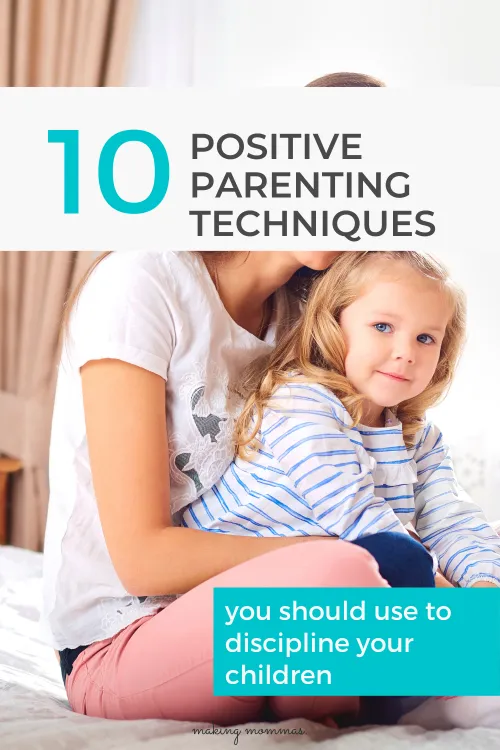
I know. I hear ya.
There ain’t no mom who hasn’t been there, done that.
But today, I’m going to show you a new way.
Today, I’ll show you the system I use – the secret to raising such amazing young men. I have all boys – the youngest are 8-year-old twins, and the oldest is 24.
All throughout my parenting years, I’ve been told, time and time again, how amazing my boys are. How kind, respectful, and sweet they are. And just how much fun they really are!
And it is all because I learned positive parenting when my oldest was still a baby. I implemented these techniques 24 years ago, and still use them, today.
And I’m here to tell you – positive parenting works! And it’s not as hard as it looks. Or sounds.
What is positive parenting?
There are a lot of fancy definitions of positive parenting. For instance, some researchers have defined positive parenting as “the continual relationship of parent(s) and a child or children that includes caring, teaching, leading, communicating, and providing for the needs of the child consistently and unconditionally”.
I, on the other hand, define positive parenting as a toolbox of parenting techniques that you can use to teach your child and manage your child’s behavior.
It is not made up of just one approach or one way of doing things but is in fact a multitude of different tools and techniques, to ultimately raise your child in a positive, loving, nurturing home.
Parents who use positive parenting are:
nurturing
empowering
sensitive
caring
emotionally warm and affectionate
consistent
empathetic
thoughtful
respectful
They know how to correct problematic behavior by leading their child towards the right decisions, rather than demanding that a child does something just because “mom said so”. This in turn helps the child to internalize the correct behavior.
They also know how to set and keep boundaries, how to listen and communicate effectively, and they have ample child development knowledge.
A positive parent always has her child’s best interest in mind, even when she’s one angry momma.
These are tools that can help you keep your cool, even when your kids make you want to scream!
Here’s what makes ‘positive parenting’ different – and why experts say it’s one of the best parenting styles
Positive parenting is different because it is a whole set of parenting styles and techniques, not just one.
Some techniques work great for some behaviors, and others work well for others. Likewise, some kids respond better to certain techniques than others do, too. Positive parenting is awesome because it gives you a whole toolbox of parenting tools to better manage your child’s behavior.
And each technique builds off and compliments the others.
Why is positive parenting important?
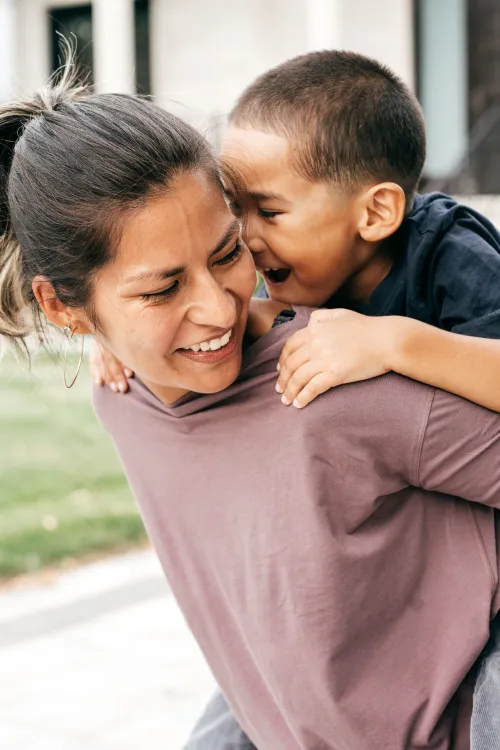
Positive parenting not only makes parenting easier for you, but it also helps your child’s growth and development.
Positive parenting encourages your child’s:
emotional growth
cognitive growth
social growth
Positive parenting is the key to all things parenting! It is the foundation of your parenting style because it focuses on your parent-child relationship.
Just think: instead of reacting horribly and flying off the handle the next time your four-year-old pins your two-year-old to the ground, you can react calmly because you know that this is normal behavior for a four-year-old.
You have the tools to effectively handle your child’s behavior, while still reaffirming your love for your child.
This, in turn, builds your relationship with your child. Children automatically want to please their parents. Especially if they feel loved and valued by their parents. So, just by using these tools, you are building your relationship with your child and reinforcing good behavior!
How can positive parenting help a child’s growth?
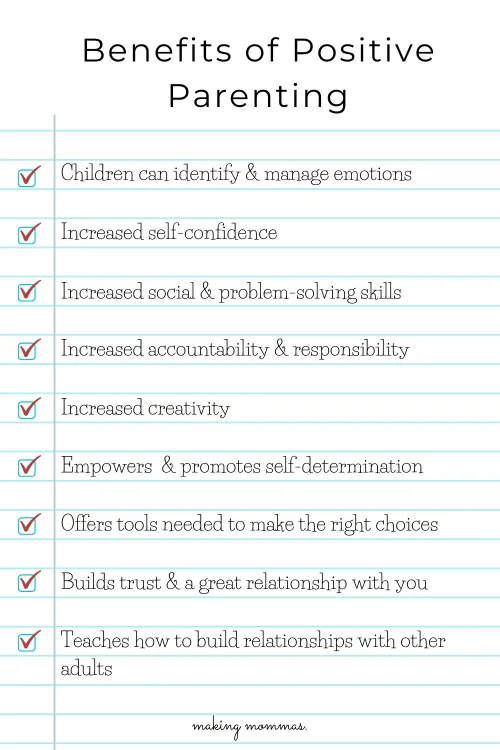
Positive parenting can help your child to develop healthy emotional, cognitive, and social skills.
Positive parenting:
1. Teaches children how to identify and manage their emotions.
Positive parenting techniques, especially emotion coaching, teach children how to identify, properly label, and manage their emotions.
Through positive parenting, children’s emotions are recognized and validated. This then gives them the opportunity to correctly display their emotions and react appropriately in any given situation.
In fact, a 2005 study found that warm, supportive parenting fosters emotional self-regulation in children.
This is because your child is not overstimulated by your negative reactions to bad behavior. So, your child is better able to respond to your attempts at guiding behavior.
When your child is constantly yelled at and talked down to, all your child can focus on is how you just made him feel about himself.
Your child cannot switch his bad feelings off and focus on what you are now trying to teach. But, if you use positive parenting techniques, then you are responding to your child’s inappropriate behavior with calmness and understanding.
He feels loved, affirmed, and empowered to make the changes you are suggesting. Your child can then focus on what you are trying to teach because he is not so busy feeling bad about himself.
2. Builds self-confidence
It’s no secret that your child is more confident if your child knows he is loved! We are all so much more confident when we know we have our friends and family backing us up, loving us unconditionally no matter what.
If you use positive parenting, your child will always know what behavior is expected, as well. It gives your child a clear understanding of the rules and the consequences of breaking those rules.
Knowing what to expect, in any given situation, builds confidence.
If your rules are forever changing, depending on the mood you are in, or what you are busy with that day, then your child just doesn’t know what to expect! He doesn’t know how to behave, because what was allowed yesterday is apparently taboo today, or vice versa.
That depletes his confidence.
3. Enhances self-esteem
A 2017 study found higher levels of self-esteem in children who felt their parents actively encouraged and supported them. These higher levels of self-esteem carried over into their teen years.
The positive parenting approach is designed to help your children make their own decisions. Your job is to encourage and support them, as they practice these skills.
When you use positive parenting, you learn to use teachable moments. Kids make mistakes all the time. But, instead of beating them up for it (figuratively speaking, of course!), you use the mistake as a jumping-off point for a better choice next time.
This fosters self-esteem and self-confidence in your child’s ability to make his own decisions.
4. Promotes social and problem-solving skills
When you use positive parenting, you actively teach your child the appropriate social behavior for a wide variety of situations.
But more than that, you encourage your child to practice his own skills.
It’s kind of like when your child was 18 months old, and he just learned to walk. He would toddle away from you, off to explore the big wide world, and then come running back in tears!
This is because it was scary, wandering away from mom.
When your child is busy practicing social and problem-solving skills, the consequences of mistakes can be detrimental. It can mean lost friendships, time outs, angry teachers, and so much more!
Your child doesn’t need you to join ranks with everyone else stacked against him. He needs you to be loving and supportive, helping him to figure out where he went wrong, and what he can do better next time.
This, in turn, builds self-confidence; your child learns that he can handle any situation.
5. Teaches accountability and responsibility
Positive parenting does not just let your kids get by with whatever they want to, for the sake of building that relationship. You still teach consequences.
Positive parenting uses logical and natural consequences whenever possible. This helps your child to learn that there are real consequences for his behavior.
A 2013 study found that physical punishment does not help a child to internalize the behavior you are trying to teach. If you spank your child for running into the street, your child may not run into the street when you are around, because he is afraid of that spanking.
But if you aren’t around? What’s going to stop your child? Certainly not a spanking.
Logical consequences, on the other hand, would teach your child to wait for you to cross that street.
If your child runs into the street, you could call him back to you and make him wait two minutes, before trying again. Then instruct your child to look both ways and hold your hand before crossing the street.
This will instill the practice of waiting, looking both ways, and holding your hand, rather than just running out into the street and hoping mom doesn’t catch you.
Teaching your child in this fashion helps your child to take responsibility for his own behavior, rather than just avoid getting caught.
6. Teaches creativity
A 2022 study found that positive parenting is positively associated with creativity and self-esteem. The study indicates that building self-esteem is important for fostering creativity in children.
This is because positive parenting allows your child to practice cognitive, social, and emotional skills without the pressure to feel, think, or behave in certain ways.
The study found that pressuring a child to perform in a certain way limits the child’s creativity and diminishes that child’s self-esteem.
Positive parents, instead, support their children as their children practice life skills and problem-solving skills.
7. Empowers your child and promotes self-determination
Positive parenting empowers your child to make their own decision in every situation. Hopefully, it’s the right one! But it isn’t always.
And that’s okay.
With positive parenting, your child feels confident in his ability to make his own decision. He knows he has your full love and support, even if he fails.
A secure child knows that messing up doesn’t mean he is a failure, or that you don’t love him. It simply means that he made a mistake, and most mistakes are fixable.
8. Gives your child the tools needed to make the right choices
Not only does positive parenting empower your kids to make their own decisions, but it gives them the tools they need to make the right decisions.
This is because they:
have clear expectations and know the rules
know the consequences of breaking those rules
have had ample time to practice their decision-making skills, social skills, cognitive skills, emotional skills, and problem-solving skills
have made mistakes and are comfortable making mistakes
understand the consequences of their actions and are willing to accept responsibility for those actions
are secure in who they are
have a secure, trusting relationship with you
You teach your child all of that, by parenting positively!
9. Teaches kids how to build relationships with other adults
Your relationship with your child is the foundation of parenting positively. If you have a good, healthy relationship, your child feels loved, validated, and supported.
Your child has trust in you.
And your child is willing and emotionally able to listen to and welcome your guidance.
But a good relationship with your child does so much more than that!
A healthy parent-child bond models healthy relationships and positive interactions for your child, so that your child can identify “good friendships” and healthy dating relationships later in life.
Your child will also know how to appropriately interact with authority figures and the elderly.
Your child can apply the relationship-building skills he’s learned from you and your relationship to all relationships, including marriage and his own children.
Positive parenting techniques, such as active listening, open communication, emotion coaching, and using teachable moments, all help to instill the skills needed to develop these healthy relationships.
10. Builds trust and a great relationship with you
And that is the key to all things parenting!
Your relationship with your child is the foundation of all of your parenting endeavors. It will literally make or break your parenting.
A 2008 study found that positive parenting promotes trust and a healthy attachment between mom and child.
This is because it uses attachment, authoritative, and developmental parenting as some of its parenting techniques.
Attachment refers to the relationship between you and your child. A secure, healthy attachment (or relationship) is one that provides a sense of security for your child.
If you can build a secure attachment with your child, then your child can trust you to support him as he practices all of the life skills you are trying to teach.
You are supposed to be your child’s biggest cheerleader. (Not to be mistaken for the role of the best friend.) Your child needs to know that no matter what he does, he will always be welcomed back into loving arms, to regroup and try again.
Much like that toddler running back to momma for reassurance.
Benefits of positive parenting strategies – and why I’ve always used positive parenting
What are the benefits of practicing positive parenting? You mean besides emotional, cognitive, and social growth?
All in all, positive parenting helps your kids to internalize what you are teaching them.
This means your kids will make the right decision in almost all circumstances because it is the right decision to make. They know right from wrong and will freely choose to do right, even if you aren’t there, watching.
Children who have not internalized what their parents have taught them will only make the right decision when someone is there to “catch” them. Much like that child running into the street; he will run if there is no threat of a spanking.
But if he’s internalized the lesson, he chooses to look both ways before crossing, even when there is no adult around.
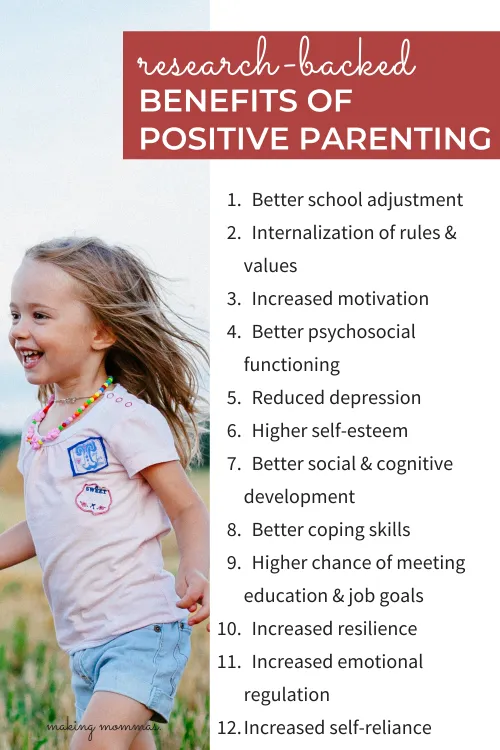
A lot of research shows that positive parenting simply sets your child up for overall better life success:
Joussemet, Landry, & Koestner, in a paper published by the Canadian Psychological Association in 2008, found that positive parenting results in better school adjustment, higher internalization of values, rules, etc., increased motivation, and better psychosocial functioning.
Duineveld, Parker, Ryan, Ciarrochi, & Salmela-Aro, in a 2017 study published in the National Library of Medicine, found that positive parenting reduces depression and increases self-esteem, especially among teenagers.
Juffer, Bakermans-Kranenburg & van Ijzendoorn, wrote about their research on attachment-based intervention in a 2008 book, showing that a secure parental attachment is better for social and cognitive development.
Sandler, Wolchik, Tein, & Winslow, found that children had better coping skills with positive parenting and that this type of parenting set adolescents up for meeting education and job goals, in their 2015 study published in Child Development Perspectives.
Kumpfer & Alvarado found that positive parenting increased child resilience, in a 1998 program study from the Office of Juvenile Justice and Delinquency Prevention, and implemented by the Strengthening Families Program.
Bornstein cited many studies that showed positive parenting increases emotional regulation and self-reliance in his 2002 book, The Handbook of Parenting.
If you want to set your child up for a lifetime of success, start using positive parenting!
I’ve been doing it for 24 years now, and I can tell you – it works! I know this because my oldest three had no significant problems in school, and are all kind, successful, contributing members of society. And my youngest three – I am told all the time how sweet, respectful, and hard-working they are, especially by their teachers.
In fact, I literally received this email this morning, from Toot’s teacher:
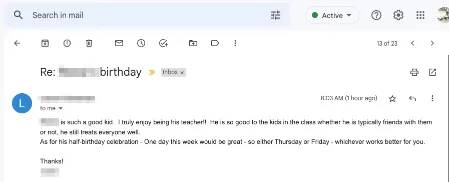
The proof is in the puddin’! Positive parenting works.
The best positive parenting techniques
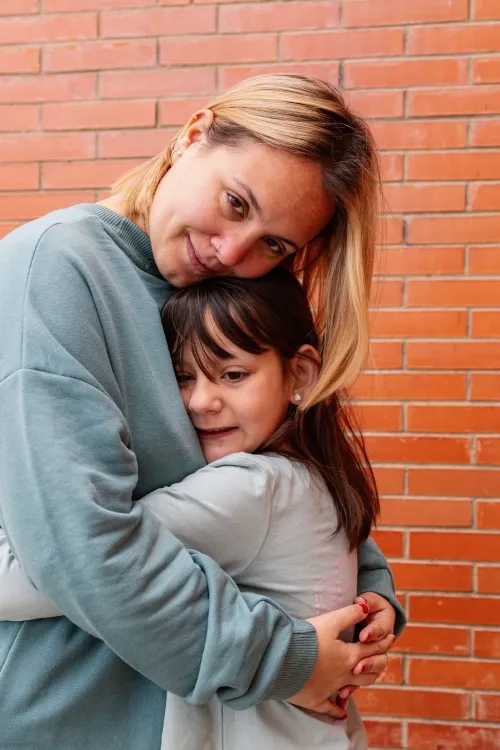
Positive parenting is not one strategy that you need to learn and be done with. And honestly, it is also not an easy parenting style to implement.
This is because positive parenting involves many parenting techniques, not just one. It takes many months to learn these techniques, and many more to appropriately use them.
But don’t lose heart! Everything worth doing takes time.
Just start with one and slowly build on that one, adding a new strategy as you feel able. And before you know it, you’ll have a whole toolbox full of techniques!
1. Warm parenting
Warm parenting simply means being loving and affectionate towards your child. Parents who use warm parenting provide regular support, consistently validate their child’s feelings, and speak to them in a friendly, loving tone.
In contrast, cold parents parent with criticism and control, with unforgivable guidelines.
2. Positive reinforcement
Parents who use positive reinforcement offer rewards for good behavior, more so than punishment for bad behavior. These rewards do not have to be physical items, though. Parents often use praise, affection, appreciation, and extended or increased privileges as rewards for good behavior.
In contrast, punitive parents will punish bad behavior.
3. Supportive parenting
Supportive parents always have their child’s best interests at heart. They are present and involved in their child’s life.
They actively encourage their child to do their best, listen without judgment, and always seek to understand where their child is coming from.
In contrast, uninvolved parents ignore or dismiss their children.
4. Open communication
Open communication is one tool used for many positive parenting styles, including supportive parenting.
Open communication allows children to freely express their thoughts and ideas without fear of judgment or punishment. It also involves using, modeling, and teaching good communication skills, which will benefit children for their entire life.
In contrast, parents who don’t communicate well ignore, lecture, and yell at their children.
5. Provide boundaries
Positive parents look at rules as more of a safe boundary for their children.
Consistent boundaries help children to feel safe and secure. They create predictability in a child’s life and reduce anxiety.
In contrast, parents who don’t provide boundaries either have very strict rules or no rules at all.
6. Logical and natural consequences
Logic and natural consequences show children that if they do a., then b. will happen. They are a natural product of a choice the child made.
A natural consequence is literally the result of a child’s actions. You do not shield your child from experiencing what would happen from the choice that he makes.
A logical consequence is a punishment chosen by the parent, related to the behavior. If used, it is because the natural consequence is too dangerous to let the child experience.
In contrast, parents who don’t use natural and logical consequences simply punish their children.
7. Distraction and redirection
Distraction and redirection are often used in younger children in the place of consequences. They are a way to encourage positive behavior without reasoning or explaining, which is often harder for younger children to grasp.
If your child is doing something you do not like, you simply redirect his attention to something else.
In contrast, a parent who doesn’t use redirection might simply yell or punish the child.
8. Offering choices
Offering choices is another great way to encourage positive behavior in younger children, without engaging in a power struggle. Getting to choose empowers a child to take charge of his own autonomy and teaches decision-making skills.
In contrast, parents who don’t offer choices may often find themselves in a power struggle, because they simply barked orders.
9. Active listening
Active listening is one component of open communication. It is a good communication skill for you to have because it validates and reassures your child that you not only hear him but also understand him and where he is coming from.
In contrast, a parent who doesn’t actively listen will ignore, belittle, or lecture the child.
10. Teachable moments
Parents who use positive parenting are always looking for natural, teachable moments. These might be moments in which your child is genuinely interested in something, and you can use that moment to teach. Or they might be moments when you can pause the action and show them more appropriate behavior.
In contrast, parents who don’t use teachable moments tend to lecture or explain more.
11. Emotion coaching
Parents who are aware of and tune into their children’s feelings use emotion coaching. They consistently notice and validate their children’s emotions. They also teach their children to appropriately identify, label, and express their emotions.
In contrast, parents who don’t use emotion coaching dismiss or chastise their children for feeling a certain way.
12. Attachment parenting
Parents who use attachment parenting respond sensitively to the needs of their children. They create warm, loving relationships with their children and work to continuously build these relationships. These parents recognize the need and the benefits of a secure parent-child bond.
In contrast, parents who do not engage in attachment parenting have no relationship with their child, or a harmful relationship with their child, which is detrimental to the child’s emotional, social, and cognitive health.
13. Developmental parenting
Developmental parenting promotes positive child development by providing affection, attending to the child’s nonverbal cues, encouraging and supporting a child’s capabilities and interests, and using play to teach.
In contrast, a parent who doesn’t use developmental parenting will ignore a child and be totally uninvolved in his life.
14. Authoritative parenting
Authoritative parents are nurturing, responsive, and supportive, but they set firm limits for their children. They are assertive and demanding but in a good, fair way.
In contrast, nonauthoritative parents might be intrusive, demanding, uninvolved, and punitive.
How to ‘parent positive’
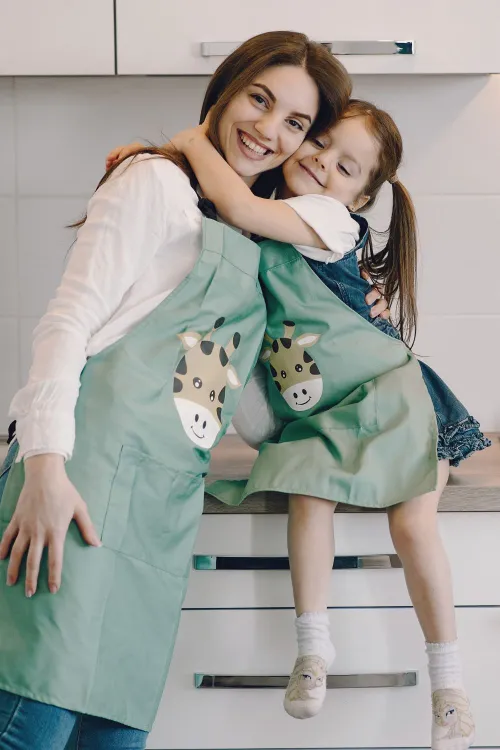
So, how do you actually practice positive parenting?
I’d start by learning as much as you can. Do some research online, read a few books, and enroll in a few courses. That is how I learned.
As you learn, start practicing what you are learning.
Here are a few easy ways to get started:
Encourage your child to try new things
Support your child with new interests
Involve your child in individual and family decisions
Pay attention to your child’s nonverbal behavior
Deliberately set family rules, working together with your husband
Be consistent with consequences
Be a role model for your child in all situations
Create a positive home environment
Learning how to parent this way can be overwhelming. But it doesn’t have to be. Just take it one step at a time.
Focus on being involved in your child’s life and building a secure relationship. That’s a great place to start. And then use the positive parenting tips below to build off that!
23 positive parenting tips to get you started
Use these tips to practice positive parenting skills every day!
1. Think of discipline as teaching and bad behavior as a mistake. When you discipline your child, your job is simply to teach the appropriate response, and then let your child practice that new skill.
2. Be respectful and treat your children exactly how you want to be treated. They are real people too, with real feelings.
3. Use praise only when earned. Don’t dole it out for every little thing.
4. Let your child “overhear” you talking good about him rather than bad.
5. To avoid a power struggle, give your child two choices you can live with. For example, ask your child, “Do you want to brush your teeth first or read a story first?” at bedtime.
6. Use “when” and “then” to encourage cooperation. For example, instead of telling your child that he cannot have screen time until he cleans his room, say, “After you clean your room you can have screen time.”
7. Always let your child know you love him, by validating his feelings, before correcting the problem. For example, say, “I can see you are really angry with your brother for breaking that train track. I would be too!” This lets him know that you understand how he feels. And then you can address the situation with, “But we can’t hit when we are angry. What can we do instead?”
8. Make the timer the bad guy to encourage cooperation. For example, “We only have ten minutes to play. When the timer beeps we have to start getting ready for bed.”
9. Know your child’s developmental stages.
10. Prevent bad behaviors from happening. Anticipate your child’s needs ahead of time and plan for them.
11. Don’t compare your children to each other. This encourages sibling rivalry.
12. Don’t label your children. This can create a self-fulfilling prophecy.
13. Spend time with each child individually, to build that parent-child relationship.
14. Let your kids practice their skills before intervening, but know their signals. When you know it’s going to get out of hand, intervene.
15. End the play or activity while everyone is still having fun.
16. Never criticize your husband, talk badly about him, undermine his authority, or undo his consequences. You need to always come across as a united front.
17. Focus on the reason why your kid is misbehaving. He’s trying to communicate something with his bad behavior. What is it that he needs? Show him how to get his needs met in a better way.
18. Always say you are sorry.
19. Always say I love you.
20. Take a time out when you feel frustrated, angry, or overwhelmed.
21. Be consistent; never bend the rules one day and then expect them to follow them the next.
22. Always follow through on your threats and promises. Your kids learn to trust that you mean what you say that way.
23. Forgive yourself. We all make mistakes, and kids are so willing to forgive! You need to do the same.
At the end of the day…
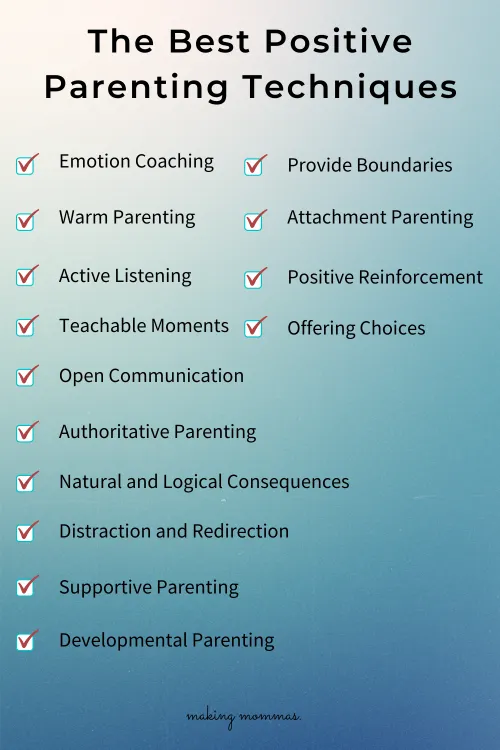
That was so much information!!
At the end of the day, momma, you need to remember that it all starts with your parent-child relationship.
It is the key to all things parenting; your foundation.
If you lay the correct foundation, you can build your child up to withstand everything life is going to throw at him.
You have to get your relationship right before your child is going to be willing to work with you and accept your guidance.
When you have a strong parent-child relationship, the rest is easy! It comes naturally!
Start there, and if you have any questions, I’m happy to help! Just put them in the comments below.
My favorite positive parenting techniques for toddlers & preschoolers
1. Giving choices
2. Attachment parenting
3. The art of distraction and redirection
5. Emotion coaching
